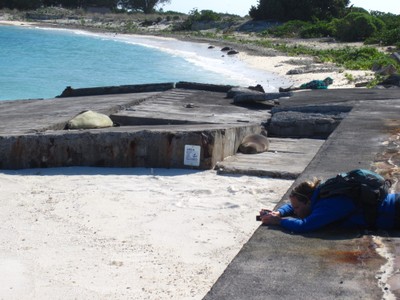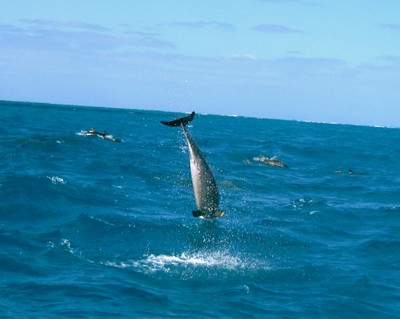(Except when CEM students observe the spinner dolphin population in the waters of the Midway Atoll). Today we spent the day on Midway Island in typical fashion—observing the spectacular wildlife, and pondering the implications of a co-management, three agency regime for the survival of Midway Island.
This morning life on Midway Island started out with our class planting approximately 300 native bunch grass plants. Next, we biked (beach cruiser with basket style) down to Turtle Beach and happened upon three Hawaiian monk seals. Two of the seals were hauled out on the land, and one was swimming in the water. We found out later from Tracy Wurth, research biologist for the NOAA Monk Seal Program, that the third seal was recently injured and therefore could not haul herself out of the water.
Managing the Critically Endangered Hawaiian Monk Seals
Hawaiian monk seals are critically endangered and only about 1,200-1,300 exist between the main Hawaiian Islands and the Northwestern Hawaiian Islands (where Midway is located). They are the second most endangered pinniped species in the world, and the most endangered pinniped species in the U.S. They also occur entirely within U.S. boundaries. This means the United States is directly responsible for managing this species and bringing it back to a viable population status. The species is decreasing at a 4% per year here in the Northwest Hawaiian Islands, though the small population in the main Hawaiian Islands is currently increasing at 7%.
Last week in Honolulu we spent time discussing the challenges of conserving this species with Charles Littnan of NMFS (see Greg’s blog post), but coming to Midway really hits home how hard it is to protect an endangered species. For more information on the proposed translocation program of monk seals from the Northwest Hawaiian Islands to the main Hawaiian Islands, go here.

The monk seals here in the Northwest Hawaiian Islands are well studied, bleached with numbers, otherwise undisturbed, and afforded every protection the humans here can give them. Apart from Tracy and her colleagues, no one is allowed within 150 feet of a seal. People speak in whispered voices (and reverend tones) when they are in view of a seal so as not to disturb it. Large stretches of the beaches on this island are closed so that monk seals can get their rest and go about their business without having to worry about us humans disturbing them. Yet, the monk seal population continues to decline. Why?
It is likely a combination of reasons, but monk seal biologists believe it is mainly because the juveniles are not surviving to adulthood. This is probably because they are not finding enough food to eat.

The seal we saw swimming today was a female born in 1991 (ID: YO2). In the picture, the scar on her back are from an older shark bite. Her current injury, probably from a large tiger shark, makes her unable to haul out onto the shore to rest. Tracy told us tonight that she is 21 years old and has had 12 pups in her lifetime, but that only two to three of these pups are still alive. This is not uncommon for the monk seals here.

Aside from the biological complexities of managing the monk seal population, you also have to factor in the management complexities. Tracy and Charles work for the Hawaiian Monk Seal program of the National Marine Fisheries Service, which is a division of NOAA. However, Papahānaumokuākea Marine National Monument is co-managed by three agencies; the Fish and Wildlife Service (land management), NOAA (in water management), and the state of Hawaii (cultural aspects). Individual field biologists from the different agencies work together well on the ground, but making the three agencies mesh together is a challenge.

The tensions involved in this three partner management system were apparent this weekend, as Midway hosted Fish and Wildlife officials from the regional and D.C. offices for a planning meeting. It was clear that the people in this organization are passionate about protecting wildlife and want to reach a younger and wider audience. However, it was also clear that bureaucratic divisions exist between the three co-trustees. This highlights the challenges of ecosystem based management when more than one agency is involved in managing protected areas.
Building a sense of cooperation among these agencies and a feeling that everyone is in it together would certainly be advantageous for Midway Island, and perhaps is the biggest obstacle and challenge in the management of the monument. An excellent way to start could be inviting people from all three agencies for a planning weekend here on the island.
Even though it’s all about the wildlife, it all comes back to people getting along…
Stop Giggling at the Spinner Dolphins
We continued this afternoon with a trip out to visit some of our favorite friends on the islands, the spinner dolphins. Our professor Andy Read, a marine mammal biologist, was all business and methodically photographed the dolphins for use in the Pacific Islands Photo Id Network.

However, the same could not be said of us Midway Island virgins. Yes, we giggled, laughed, and squealed at the sleek and slender spinner dolphins, about 150 in total around our boat. They dove, spun, flipped, and moved through the water with unbelievable grace. Words were hard to come by to describe the magical presence these magnificent creatures held over our group.
But of course there is a management issue with the spinners as well—that’s why we’re here, right? The spinner dolphins are unique in that they spin out of the water to communicate with each other that’s it’s time to wake up and start playing or foraging.
They like to rest in shallow bays during the daytime away from predators, and forage out beyond the reef at night. However, in the main Hawaiian Islands, this means they are often disturbed during the daytime by tourists swimming along the coasts or on eco-tourism boats, often hoping to fulfill their lifelong dream to “swim with a dolphin”. Detrimental effects occur because the dolphins have to be alert at times when they should be resting. Therefore, over time their fitness levels will likely decrease because of the constant interactions with humans. How would you feel if someone was constantly waking you up every night and never let you get a good night’s rest?

Managing a healthy spinner dolphin population will require educating people about the harmful effects of swimming with the dolphins. Of course, this will also impact the ecotourism industry, which is a large part of the economy in the main Hawaiian Islands. And after watching the dolphins today, it’s not hard to understand why people would want to get close to this tremendous animal.

Our trip out to see the spinner dolphins today was headed by our boat driver, Pete Leary, the refuge biologist biologist from Fish and Wildlife. Pete is an excellent ambassador for the island. For information and updates about Midway Island, I recommend his blog, peteatmidway.blogspot.com.

